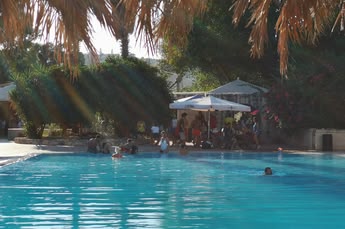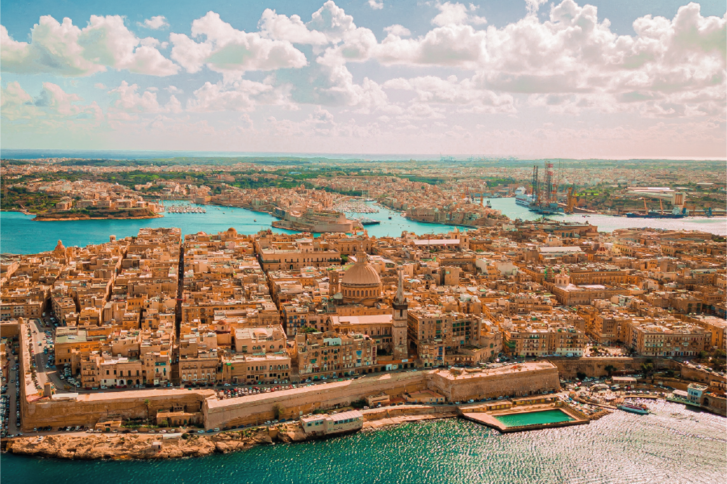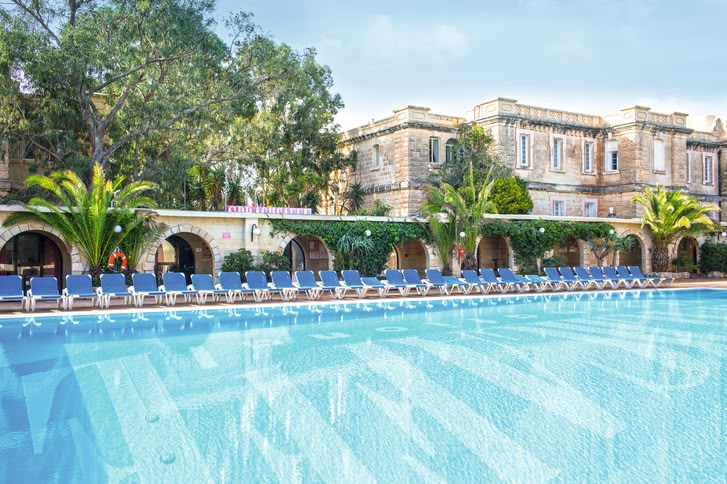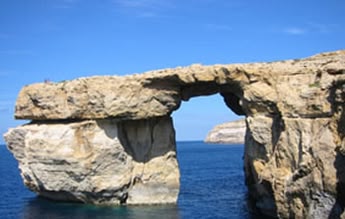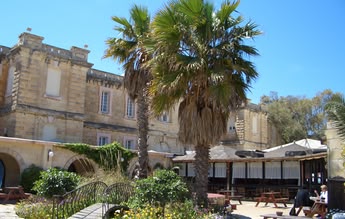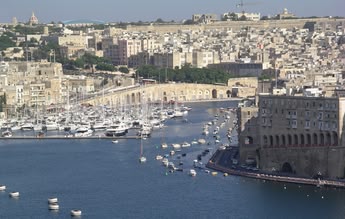The Ultimate Travel Guide to Malta
Endless Sun, Stunning Beaches, Unforgettable Memories
A visit to Malta is a blend of past and present, with the island's rich history reflected at every turn. The archipelago, known for preserving the old-world charm of its cities and towns, is set against truly scenic backdrops. What's unique about Malta is its bilingual nature, offering a natural environment for learning and practising English outside the confines of a classroom. Visiting Malta, students of all backgrounds can merge their educational pursuits with leisure, making the archipelago a preferred destination for young language learners.

The prevalence of English is evident as newspapers, books, and broadcasts predominantly use it, making immersion into the language effortless. Beyond learning, there's much to adore about Malta, including the pleasant Mediterranean lifestyle, festivals and events in Malta marked by delightful cuisine, sunny weather, and warm spirited people.
Before entering the country, non-European nationals must fulfil Malta's visa and entry requirements, which are straightforward for most citizens. The pleasant climate, vibrant nightlife, quaint towns, inviting cafés, and picturesque beaches, all underlined by a deep cultural heritage, speak volumes about Malta. Discover the ultimate blend of relaxation and adventure in Malta, where you can immerse yourself in English learning and discover endless fun! From thrilling activities to exploring the island's rich culture, there's something everyone, whether you're a young traveler or young at heart. Get ready to explore all the amazing things to do in Malta.
Our Leisure Programmes
We're thrilled to introduce our enthusiastic team of leisure coordinators and community managers, who are dedicated to spicing up your stay with an array of fascinating experiences, excursions, and activities! Each week, they curate a fresh and exciting program, showcasing the best adventures Malta has to offer. Our coordinators are just a hop, skip, and a jump away whenever adventure calls your name. And for those days when you're craving some downtime, our serene pool awaits. Here, you can lounge in tranquility, soaking up the sun and enjoying the peaceful ambiance. We respect your space and promise a disturbance-free zone for your relaxation. It's all about what makes you happiest - whether it's seeking new adventures or unwinding in peaceful bliss!
Activities for Young Travellers
Activities of the Junior Programme
Experience an exciting mix of language learning and adventure in Malta with Sprachcaffe! Our Junior Activities are packed with fun, from horse riding to go-karting, and shopping in the bustling streets of Sliema. Explore the historic charm of Valletta, the captivating Blue Lagoon, and Malta's breathtaking landscapes through our specially designed excursions. Whether staying for two or three weeks, enjoy a range of activities including lively beach parties, karaoke, and student nights in Paceville. Enhance your adventure with the Intensive Leisure Fun Pack for even more exploration options. Join Sprachcaffe for a memorable journey of learning and fun, all under the guidance of our experienced group leaders.
Engaging Experiences and Excursions
Activities for individual travellers
Dive into a world where language learning meets adventure! Sprachcaffe Malta offers a unique English learning experience, seamlessly integrating classroom knowledge with the vibrant life of Malta. Picture yourself practicing English against the backdrop of Malta's stunning beaches, historic streets, and lively social scenes. From the crystal-clear waters of St. Peter's Pool to the ancient walls of Mdina, each step is a new opportunity to use and improve your English. Our activities are designed to maximize your learning while immersing you in the island's rich culture. Whether you're exploring the markets of Marsaxlokk or dancing the night away in Paceville, you're not just learning a English; you're living it.
Where is Malta?
Malta is a small country located in the Mediterranean Sea, south of Italy and east of Tunisia, with the closest land being Sicily, an Italian island. Malta itself is an archipelago, consisting of several islands. The island state includes the three inhabited islands of Malta, Gozo, and Comino, as well as the uninhabited islands of Cominotto, Filfla, St. Paul's Island, and Fungus Rock. Malta is the largest and most populated of these islands, covering just over 316 square kilometers and stretching 27 kilometers in length.
In terms of transportation, Malta is well-connected by air and sea. The main international airport serving the country is Malta International Airport (MLA), located near the capital city of Valletta. The airport offers flights to numerous destinations in Europe, North Africa, and the Middle East. Additionally, Malta is accessible by ferry from various Mediterranean ports, including Sicily.
For budget-conscious travelers, several budget airlines operate within the region, offering affordable air travel options to and from Malta. These budget airlines provide convenient connections to major European cities and beyond, making travel to Malta accessible for a wide range of travelers.
Malta's topography is predominantly low-lying, with limestone formations and rocky coastlines defining its landscape. The highest point on the islands is Ta' Dmejrek, standing at 253 meters above sea level. Despite its small size, Malta boasts a rich cultural heritage, influenced by its strategic location and history of colonization. The official languages are Maltese and English, reflecting its diverse linguistic and cultural heritage. Malta's membership in the European Union since 2004 further enhances its connections with neighboring countries and the broader European community.
When should you go to Malta?
Due to its geography, Malta is sunny almost all year round! But like any place, the weather does vary depending on the season. Find out when the rainy season on Malta is, get suggestions on fun activities to do around the island based on when you go there, and know what the expect when planning your trip with our handy guide on the best time to travel to Malta.
Malta Visa and Entry Requirements
Travelling and working in Malta can be an exciting experience, but it's important to understand the visa requirements to ensure a smooth stay, especially as these requirements vary for EU and non-EU citizens.
For EU Citizens: If you're from the European Union, the process is straightforward. For short visits, you don't need a visa to enter Malta. You can stay up to three months (90 days) with just your passport or identity card. From March 1 2024, our students from visa-exempt countries will be able to extend their course and apply for a visa extension after entering the Schengen area for their first 90 days. Students will need to prove that their original reason for entry was to study for less than 90 days, which can be proved with attendance records showing 75% or above. Students who book a course for more than 12 weeks will benefit from the extended visa service offered by Sprachcaffe before arriving to Malta.
For Non-EU Citizens: For those from outside the European Union, the process is more complex. Visiting Malta for short periods may require a Schengen visa, depending on your home country. This visa allows travel across the Schengen area, Malta included, for up to 90 days. Students will only be allowed to extend their visas in Malta as long as they originally enter the Schengen area with a study visa. If our students want to stay in Malta for more than 90 days a long- term study visa will be required. Students have to apply for a long-term visa using the new Extended Visa Service provided by the school.
Here you will find detailed information on the application and extension procedures for visas to Malta and the documents required.
Where to Stay While Visiting Malta
When visiting Malta, there are many budget-friendly accomodation options to choose from. Hostels are the go-to choice for many young travellers, and for good reason. Hostels offer affordable, dormitory-style accomodation with shared rooms and facilities. Hostels are not only economical, but also a social hub for meeting fellow travellers. They offer a great opportunity to practice English and make friends with other guests.
Guesthouses are also a popular accomodation on Malta. A guesthouse is similar to a hotel, but smaller. This means they are less crowded, but still offer the same facilities. For those seeking privacy and wanting their own space during their trip to Malta, guesthouses are a good option. Homestays are perfect for those seeking an authentic Maltese experience, because they offer the opportunity to stay with a local family. A homestay lets you immerse yourself in Maltese culture, practice English, and make cross-cultural connections.
Young travelers can find budget-friendly housing in university dorms, too. During academic holidays, universities sometimes open their empty dormitories to tourists. These dorms provide afforadbale housing and basic amenities. The only caveat is limited availability: reservations are often required well in advance of your trip. Still, staying in university dorms gives you the chance to mingle with other young travelers from around the globe.
Of course, Sprachcaffe's clean and safe accomodations are the perfect choice for those looking for accomodation in St. Paul's Bay, Malta. There are several options to choose from, including the budget-friendly Standard Apartment, the cosy Comfort Apartment or the more luxurious Studio Apartment. When staying at Sprachcaffe, you get the privacy and comfort of a guesthouse, the facilities of a hotel (including half or full board provided during your stay), and the social opportunities of a hostel or university dorm. The best of all accomodation options on Malta in one place!
Put Safety First While Visiting Malta
Safety is the most important factor to consider when booking accomodation. Here are some tips to help you enjoy a safe and fun stay on Malta:
- Do your research: Before booking anything, be sure to do thorough research on the accomodation's reputation and saftey standards. Online reviews from other travelers are a fantastic resource and can give you insight on the reliability and security of an establishment.
- Check the address: Opt for accomodations located in safe and well-lit areas. Bonus points if it is also close to public transportation and essentials like grocery stores and pharmacies.
- Use reliable platforms: Safety isn't just an offline concern. It is important to use reputable booking platforms or official websites when you make reservations to minimize the risk of falling for fradulent listings or getting scammed.
- Stay vigilant: Pay attention and trust your gut when you get to your accomodation. If something feels off, don't hesitate to arrange alternative housing or reach out to local authorities.
Public Transportation
Moving around Malta is pretty simple. There are many buses going all around the island, and it's not very expensive. The country is small, so it doesn't take too long to go from one part to another. There are also ferries to go to the other islands like Gozo and Comino, which are beautiful places to visit! Here you can find out for yourself how to get around Malta without a rental car.
Malta's Important Landmarks
Malta is bursting with natural beauty and secret treasures. Here on this Mediterranean gem, you can casually wander through the streets of the UNESCO-listed capital, where ancient architecture mixes seamlessly with modern city life. And if you're craving a break from the hustle and bustle, just slip away to Malta's hidden coves and crystal-clear waters, where you'll find secluded caves and picture-perfect beaches waiting to be explored.
Let's discover the island's must-see spots, where ancient temples stand as quiet reminders of Malta's rich past civilizations. Whether you're up for an adventure, longing for some chill time, or eager to soak up some history, Malta's got you covered. Get ready for an unforgettable journey packed with surprises and awe-inspiring moments thanks to Malta's famous landmarks.
Language Schools and Resources for Young Travelers on Malta
For young travellers interested in sharpening their English skills during their trip, Malta offers an array of language schools and resources tailored to meet all kinds of learning desires. Here's a comprehensive guide to help you make the most of your Malta language trip:
1. Finding High-Quality Language Schools:
When seeking a reputable language school, you should prioritize language schools with established credentials and a track record of excellence. Look for official accreditations like the Accreditation Body for Language Services (ABLS) or memberships in recognized organizations like the Federation of English Language Teaching Organizations (FELTOM). These accreditations ensure that the school meets rigorous standards of teaching quality, student support, and facilities.
2. Choosing between Course Types:
Language schools on Malta usually have a variety of course types, so you can find one that meets your schedule and language goals. Whether you're looking for an authentic immersion experience, a part-time course to balance with other activities, or a specialized program focusing on areas like business English or exam preparation (e.g., IELTS, TOEFL), there's something for everyone. Also, many language schools on Malta have summer programs which cater specifically to young travellers, providing intensive language study combined with cultural trips and activities.
3. Beyond the Classroom:
Language learning does not stop outside the classroom, and Malta provides a unique opportunity to practice English with locals and other travelers beyond your lessons. Chat with your fellow language students to practice conversation skills and meet new people. Take part in meetings and events with like-minded language students and native speakers to socialise in a relaxed atmosphere and gain confidence in using the English language. The Sprachcaffe campus with its many opportunities is an ideal place to socialise with like-minded people. Additionally, make the most of the nearby Pembroke Public Library, which offers a quiet space to study and a diverse collection of books to enhance your learning. This library is a valuable resource for English students, providing further opportunities to immerse yourself in the language and culture.
Living Like a Local
Embracing Malta's Culture on a Budget
If you're a young traveller eager to experience Malta beyond the tourist hotspots, living like a local offers a rewarding glimpse into the true Maltese lifestyle. Here's a guide to help you navigate the ins and outs of local living while staying within your budget:
Budgeting
In order to manage your expenses and plan your budget, you must have an idea of the average costs of living in Malta. While prices can vary depending on your lifestyle and preferences, here's a rough estimate: expect to spend around €20 - €30 per day on food, €1.50 - €2 for a bus ride, and approximately €10 - €20 for entertainment activities. By budgeting wisely and seeking out affordable options, you can make your money stretch without compromising on experiences.
Where to Eat
When it comes to dining out, opt for restuarants frequented by locals rather than typical tourist spots. Look out for small, family-run restaurants and cafes tucked away in residential neighborhoods, where you can enjoy authentic Maltese cuisine at reasonable prices. Explore areas like Msida, Gżira, and Birkirkara, which are popular with students and offer many dining options catering to different tastes and budgets.
Things to Do
Fortunately, experiencing Malta's rich culture doesn't have to break the bank. Seek out free or low-cost activities such as exploring historic sites like the Ħal Saflieni Hypogeum, wandering through the colorful markets of Marsaxlokk, or taking a relaxing walk along the scenic coastline of Sliema. Keep an eye out for cultural events and festivals happening around the island. These provide opportunities to immerse yourself in local traditions and mingle with friendly locals.
Neighborhood Guides
When choosing where to stay and explore, consider neighborhoods that resonate with your interests and preferences. Student-friendly areas like Sliema and St. Julian's offer a lively atmosphere with bustling nightlife, cozy cafes, and easy access to amenities. For a more laid-back vibe, consider quaint towns like Żebbuġ or Rabat, where you can soak up the charming streets and historical landmarks. Put safety first by staying in well-lit and populated areas, especially when venturing out after dark.
Malta's Long History
You can read about the winding streets of Valletta, a UNESCO gem shrouded in stories of knights and kings, or lose yourself in the stories of the timeless Mdina, also known as the "Silent City", on our history and traditions of Malta page.
Malta isn't just a land of historic sights; it's full of life! From Paceville's party scene to Gozo's rugged terrain, you can experience the duality of Malta-a wonderful mix of past and present, waiting to be explored.
Staying Safe and Healthy
Common Sense Saftey Tips
Malta is generally safe, but it's smart to stay vigilant, especially in crowded places or touristy spots. Keep your valuables close, avoid flashy displays of wealth, and trust your instincts. Oh, and remember to respect local customs and traditions - it goes a long way!
Emergency Resources
Know who to call in a pinch! If you find yourself in trouble, dial 112 for the police, ambulance, or fire brigade. It's a good idea to jot down the nearest police stations and hospitals, just in case. And hey, if you need a hand, your embassy or consulate can be a lifeline, so keep their contact info handy too.
Healthcare Access
Getting medical help in Malta is pretty straightforward. They've got top-notch healthcare facilities, both public and private. But here's the kicker - healthcare for visitors can burn a hole in your pocket. So, make sure you've got travel insurance that covers medical stuff, including emergencies.
A Few More Tips for Your Trip to Malta
Ready to take your Malta adventure to the next level? Try getting a head start on improving your English with these resources! We have prepared some informative pages on different aspects of the English language to help you brush up before taking off.
It doesn't hurt to learn a few Maltese phrases as well. Did you know that Malta boasts a unique blend of Mediterranean, Arabic, and European influences? Get a taste of Maltese culture with these fun facts: locals greet each other with a friendly "Ħello!" (pronounced "hello") and "ċaw" (pronounced "chow"). Want to impress your new friends? Pratice saying "Grazzi" (thank you) and "Mela" (okay). And remember, when in doubt, a smile goes a long way!
10 Facts About Malta
This is the main reason why English is the second official language of the country and is widely spoken by the population. Malta is considered to be one of the best places to study English because it combines interactive teaching, a large native-speaking population, great weather, sea, sun and fun, competitive prices and good accessibility.
The sun shines more than 3,000 hours each year, one of the highest rates in Europe. Malta enjoys warm, sunny weather most of the year which attracts a lot of tourists. The temperature never goes below zero and is 26°C on average in summer and 15°C in winter during the day.
According to a United Nations report Malta is listed in second place in terms of safety after Qatar. The index is based on 4 factors: exposure to natural hazards such as earthquakes, hurricanes and floods, level of infrastructure, governance and adaptive capacities to future climate change. Malta also has a very low crime rate for both violent and petty crime. The fatal road accidents rate is also extremely low. Tourists are usually advised to be careful with their belongings and when crossing streets as driving is on the left like in the UK.
Maltese history, culture and architecture owe a lot to the famous Knights of St. John (also known as the Order of Hospitallers and Maltese Knights). The Order came to Malta in 1530 and over the centuries invested vast amounts of effort and resources into the island's military power, education and health care. They also built the fortifications of Valletta - at the time it was the most advanced fortress in the world.
Malta consistently ranks in the top positions for the cleanest bathing waters in the EU and has been given a star by the European Commission. Every single one of its 87 bathing sites reach EU standards and most of them have been given top marks and rated "excellent". Maltese waters are incredibly beautiful, featuring memorable shades of deep blue and turquoise.
Maybe not officially but Maltese summer - the time when you enjoy swimming and sunbathing - starts in early May and ends in late October. Seawater reaches comfortable temperatures in June and gets gradually warmer up to October. Visiting Malta in summer is a must for anyone who wishes to escape the dreaded cold of the Northern countries.
Students of all nations, ages and levels are welcome in Malta. The top nationalities are Italy, French and Germany and the largest proportion of language students fell within the 18 to 25 age group. Studying English in Malta is becoming more and more popular every year and the number of students is steadily growing.
And the fifth smallest in Europe at only 316 km2. It is also one of the most densely populated countries with more than 452,000 residents. Malta is a Parliamentary Republic. It is an archipelago consisting of three islands: Malta, Gozo and Comino.
Older than Stonehenge. There are eleven prehistoric monuments of which seven are UNESCO World Heritage Sites. These temples were the result of several phases of construction from around 3000 to 2200 BC.
During 2018, Valletta organised a number of events that served as inspiration to other cities based on different cultural elements.
Do you have questions about the Sprachcaffe Campus in Malta?
We are always ready to solve any doubts you might have!



